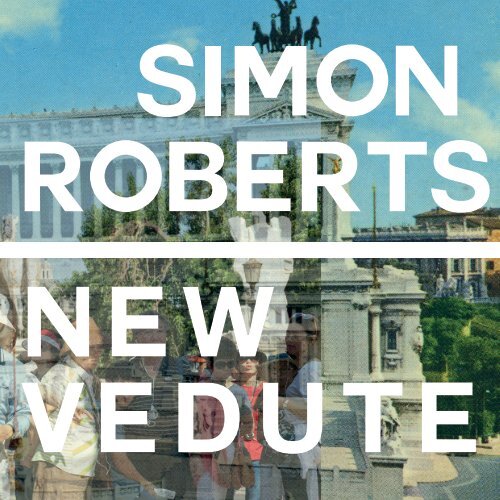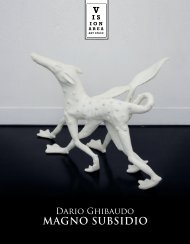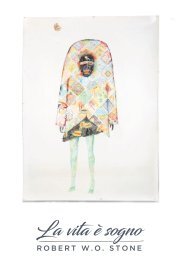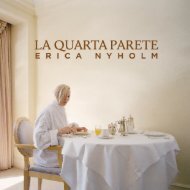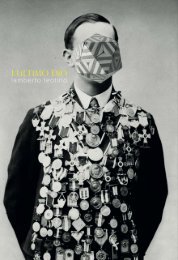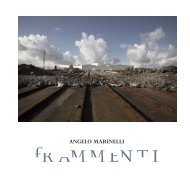Simon_Roberts_webNew Vedute - Simon Roberts
Catalogo della Mostra di Simon Roberts presso Visionarea Roma
Catalogo della Mostra di Simon Roberts presso Visionarea Roma
Create successful ePaper yourself
Turn your PDF publications into a flip-book with our unique Google optimized e-Paper software.
A cura di<br />
Curated by<br />
Claudio Composti<br />
Progetto grafico<br />
Graphic design<br />
Angelo Marinelli<br />
Comunicazione<br />
Communication<br />
ArtistProof s.r.l. Roma<br />
Ufficio stampa<br />
Press office<br />
FOSFORO, Roma<br />
Con il supporto di<br />
Supported by<br />
In collaborazione con<br />
In collaboration with
LA FOTOGRAFIA DELL’UOMO<br />
di Claudio Composti<br />
“Ogni fotografia è in realtà un mezzo per mettere alla prova, per confermare e per costruire<br />
una immagine totale della realtà” J. Berger<br />
4<br />
“The Family of Man” è una mostra icona della<br />
storia della fotografia, ideata nel 1955 dal<br />
fotografo lussemburghese Edward Steichen<br />
ed installata ora, dopo tre anni di restauro, nelle<br />
sale del castello di Clervaux in Lussemburgo,<br />
dov’è conservata e allestita dal 1994 in modo<br />
permanente. Dopo una serie di esperienze<br />
come fotografo di guerra, ma soprattutto<br />
come fotografo di moda e sperimentatore,<br />
dal pittorialismo alla Straight photography,<br />
Steichen diventò direttore del dipartimento di<br />
fotografia del MoMa di New York: è in questa<br />
occasione che concepì l’idea di una grande<br />
mostra collettiva che avesse come tema<br />
l’Uomo, inteso come parte di un tutto, di una<br />
unica grande famiglia: il Mondo. L’esibizione fu<br />
allestita la prima volta al MoMa e raccoglieva<br />
503 fotografie da 68 paesi. I fotografi coinvolti<br />
furono 273 e i lavori esposti furono selezionati<br />
tra 2 milioni di scatti inviati da autori di tutto<br />
il mondo, tra cui alcuni molto celebri come<br />
Dorothea Lange, Robert Capa, Henri Cartier-<br />
Bresson, Robert Doisneau, August Sander,<br />
Ansel Adams. Nel 1959 passò anche in Italia, a<br />
Torino.<br />
The Family of Man fu progettata per raccogliere<br />
i documenti prodotti nel secondo dopoguerra<br />
con un taglio fortemente antropologico:<br />
come un enorme album di famiglia, globale<br />
ed universale, che avesse come soggetto<br />
l’essere umano, la sua vita e i modi di agire e<br />
comportarsi nel mondo, le relazioni che gli<br />
uomini intrattengono, pur nelle differenze<br />
culturali, come parti di una comunità e membri<br />
della stessa specie.<br />
<strong>Simon</strong> <strong>Roberts</strong>, inglese classe 1974, allo stesso<br />
modo pratica questo genere di fotografia, che<br />
potremmo definire antropologica. La tematica<br />
trova altri precursori, come Paul Graham e<br />
Martin Parr, grande fotografo inglese che ha<br />
reso il cattivo gusto un tesoro da difendere,<br />
degno di un clic “…perché rende il mondo<br />
folle, divertente e colorato!” o come il tedesco<br />
Thomas Struth o gli italiani Massimo Vitali e<br />
Walter Niedermayr.<br />
Con la stessa metodicità, da diversi anni<br />
<strong>Simon</strong> <strong>Roberts</strong> gira con il banco ottico e il<br />
suo van, dal cui tetto scatta per avere una<br />
visione panoramica rialzata dei soggetti. Al<br />
centro della sua ricerca fotografica c’è sempre<br />
l’essere umano e il paesaggio antropizzato e<br />
come le grandi masse ne fanno uso, dai parchi<br />
alle città, dalla natura ai luoghi del tempo<br />
libero. Ha scattato la Russia post sovietica,
con la serie Motherland e Polyarnye Nochi.<br />
Ha indagato le usanze nel tempo libero della<br />
cultura inglese nella serie We English e la<br />
storia dei pontili inglesi nella serie Pierdom; ha<br />
scattato sulle montagne in Svizzera l’invasione<br />
dei turisti, con la serie Sight Sacralisation;<br />
(Re)framing Switzerland; ha girato il mondo<br />
per documentare la relazione tra città e parchi<br />
nella serie Urban Parks, ritraendoli alla luce dei<br />
diversi modi in cui vengono vissuti, celebrati o<br />
trasformati dalla presenza umana. In tutti i suoi<br />
lavori è impossibile scindere l’aspetto estetico da<br />
quello sociologico. <strong>Roberts</strong> riflette sui concetti<br />
d’identità individuale e collettiva soprattutto.<br />
Si prende gioco delle ossessioni tecnologiche<br />
di cui tutti siamo schiavi oggi, nella serie The<br />
Last Moment; realizzato tra il 2011 e il 2014,<br />
<strong>Simon</strong> utilizza immagini pubblicate dai giornali<br />
britannici di grandi eventi pubblici, che vela con<br />
strati semitrasparenti lasciando piccoli cerchi<br />
che inquadrano solo i cellulari delle persone<br />
riunite all’evento mentre scattano fotografie.<br />
Ironica critica dell’ enorme produzione e<br />
consumo di fotografie prodotte e diffuse ogni<br />
giorno in tutto il mondo e del nuovo ruolo<br />
della fotografia nella società contemporanea.<br />
È questo contesto socio-culturale, tecnologico<br />
e psicologico che <strong>Roberts</strong> analizza. Gioca con<br />
i clichè e gli stereotipi culturali. Come il tipico<br />
souvenir d’Italie da cartolina, nella serie New<br />
<strong>Vedute</strong> - Alternative Postcards from Italy.<br />
Qui infatti sovrappone immagini scattate<br />
da lui in Italia, a tema sociale e politico, ad<br />
immagini di cartoline originali dell’Italia anni<br />
‘50/’70, secondo gli stereotipi kitsch più tipici:<br />
la gondola di Venezia, i limoni di Sicilia, i turisti<br />
nelle piazze romane; crea così una tensione tra<br />
un paesaggio passato e una contemporaneità<br />
che ha stravolto la storia, la cultura e la<br />
bellezza del Bel Paese, come il turismo di<br />
massa, l’immigrazione e gli abusi edilizi. Con<br />
una visione non scevra da pregiudizi culturali,<br />
che dichiara come ci vedono gli stranieri da<br />
fuori. Lo stesso interesse verso i rituali sociali di<br />
massa lo ritroviamo nella serie Urban Parks –<br />
Green Lungs of the City of the city realizzato<br />
tra il 2015 e il 2016 in cui riflette sulla storia<br />
dei parchi pubblici nelle città: nel XVII secolo<br />
erano dominio riservato alle famiglie benestanti<br />
e ai reali, ma con l’avvento della rivoluzione<br />
industriale nell’800 diventano spazi pubblici,<br />
per necessità medica da un lato, dato lo smog<br />
che inquina le città e per motivi socio politici<br />
dall’altro, data la nascita di una borghesia che<br />
reclama spazi e svaghi sociali adatti ai nuovi<br />
ricchi, dentro e fuori le città; lo stesso ruolo<br />
che ebbero i Pierdoms in Inghilterra, non tanto<br />
come moli di attracco quanto sedi di teatri, caffè<br />
e giostre, meta dei primi week end fuori porta in<br />
cerca di aria salubre, in fuga dalle città inquinate.<br />
Il suo è un excursus dunque sul nostro modo di<br />
vivere come esseri umani, ovunque nel mondo.<br />
Ovunque con spazi da usare per il tempo libero,<br />
con parchi, città e case da abitare. Modi di vivere<br />
diversi, che trovano però un unico comune<br />
denominatore, che Steichen aveva intuito nella<br />
mostra al MoMA: l’essere parte di un unica<br />
grande famiglia umana, con tutte le difficoltà<br />
che ogni famiglia nasconde in sè, se è vero,<br />
come scrisse Tolstoj in Anna Karenina che “…<br />
Tutte le famiglie felici sono simili tra loro, ogni<br />
famiglia infelice è infelice a modo suo.” Per<br />
questo ognuno di noi si riconosce nelle opere di<br />
<strong>Simon</strong> <strong>Roberts</strong>, poiché la sua fotografia diventa<br />
uno specchio delle nostre abitudini, delle nostre<br />
idiosincrasie e degli spazi che chiamiamo casa,<br />
raccontati con lo sguardo di chi di questa<br />
umanità fa parte. Uno sguardo sulla Vita, nella<br />
semplicità del quotidiano e dei rituali sociali,<br />
attraverso una fotografia dell’Uomo.<br />
5
HUMANKIND’S PHOTOGRAPHY.<br />
by Claudio Composti<br />
“Every photograph is in fact a means of testing, confirming and constructing a total view of<br />
reality” J. Berger<br />
6<br />
“The Family of Man” was an ambitious<br />
photography exhibition created in 1955<br />
by Edward Steichen, a photographer from<br />
Luxembourg. Since 1994, the collection is<br />
archived and displayed at Clervaux Castle in<br />
Luxembourg, after three years of renovation<br />
work. Steichen’s early experiences in military<br />
photography were remarkable but he’s known<br />
especially as being a fashion photographer<br />
and an experimenter. He gravitated from<br />
Pictorialism to documentary photography<br />
and served as Director of the Department of<br />
Photography at New York’s MoMa. Once at<br />
MoMa he decided to mount a vast collective<br />
exhibition to present the essential oneness of<br />
mankind throughout the world. The exhibition<br />
was first shown at the Museum and brought<br />
together 503 photos from 68 countries.<br />
There were 273 photographers involved and<br />
the final works were chosen from over two<br />
million submissions sent by authors from all<br />
over the world. It included works by famous<br />
photographers such as Dorothea Lange,<br />
Robert Capa, Henri Cartier-Bresson, Robert<br />
Doisneau, August Sander and Ansel Adams.<br />
In 1959 the touring exhibition stopped in Italy,<br />
in the city of Turin.<br />
The Family of Man was intended to gather the<br />
documentation produced after World War II<br />
in an anthropological way: as a universal and<br />
global family album. The subject is “Man”,<br />
every aspect of human life, human behavior<br />
and the way we interact with each other.<br />
It is important to recognize that besides<br />
cultural differences we are part of the same<br />
community.<br />
<strong>Simon</strong> <strong>Roberts</strong>, a British photographer born in<br />
1974, equally practices this “anthropological<br />
vision” of photography. Thematically, <strong>Roberts</strong>’<br />
“vision” has its precursor in the works by<br />
British photographers like Paul Graham and<br />
Martin Parr, but also in the German tradition<br />
like Thomas Struth and the Italians Massimo<br />
Vitali and Walter Niedermayr.<br />
For the past decade <strong>Simon</strong> <strong>Roberts</strong> has<br />
travelled with his motorhome and his<br />
monorail view camera, taking photos from the<br />
rooftop so as to get a higher view. The heart<br />
of his photographic research is “Man”, the<br />
manmade landscape and how this vast crowd<br />
relates to it. He travelled in Russia providing<br />
a true glimpse of post-Soviet Russia in his
Motherland and Polyarnye Nochi series. In<br />
England he studied every aspect of the British<br />
culture, from national identity and leisure<br />
in We English to Pierdom which recorded<br />
every remaining British pleasure pier. Sight<br />
Sacralization: (Re)framing Switzerland is a<br />
spectacular view of Swiss idyllic mountains<br />
and the tourist invasion. Urban Parks<br />
documents the relationship between green<br />
spots and cities, highlighting how parks are<br />
transformed, celebrated and lived by people.<br />
In all his works the aesthetic and the<br />
sociological aspect are bound together;<br />
besides individual identity <strong>Roberts</strong>’ concern<br />
is the collective identity. In The Last Moment,<br />
a project carried out between 2011 and 2014<br />
he mocks the technological obsessions which<br />
enslaves us today. <strong>Simon</strong> chooses photos<br />
of key world events published in British<br />
broadsheet newspapers. The background<br />
is veiled by using a white ghostly layer, but<br />
every occasion in which someone is using<br />
a camera is noted and then circled, so that<br />
only the device is visible. An ironic criticism<br />
of the massive production and consumption<br />
of photos produced and spread every day<br />
throughout the world, thereby exploring<br />
the role of photography in contemporary<br />
society. <strong>Roberts</strong> analyses the socio-cultural,<br />
technological and psychological context.<br />
He also plays with cultural stereotypes and<br />
cliches as in the series of works New <strong>Vedute</strong><br />
- Alternative Postcards from Italy. <strong>Simon</strong>’s<br />
socio-political photos of Italy and traditional<br />
tourist postcards from the 50s/70s are<br />
framed one inside the other. This overlapping<br />
technique creates a tension between past and<br />
present, highlighting some of the political,<br />
social and economic challenges facing Italy<br />
today, especially in light of mass tourism,<br />
immigration and urbanization abuses. His<br />
vision isn’t free of cultural prejudice and states<br />
how foreigners see us. The same interest in<br />
social rituals can be pictured in the series of<br />
works Urban Parks - Green Lungs of the City<br />
(2015-2016). <strong>Simon</strong> reflects on the history<br />
of public parks. In XVII parks were exclusive<br />
domain of wealthy families and royalty, but<br />
by the mid 1800s urban parks were starting<br />
to be seen as a way to serve the public and<br />
latter as a remedy to social ills caused by the<br />
Industrial Revolution and overcrowding in<br />
lower income neighborhoods. Also the British<br />
pleasure piers are seen as an escape from<br />
polluted cities in search of fresh air. His work<br />
therefore outlines our way of living as human<br />
being, anywhere in the world, picturing us in<br />
parks, cities and in our homes. Different ways<br />
that find a common ground that Steichen<br />
had sensed in MoMa exhibition: we are part<br />
of a huge family with all the difficulties every<br />
single family has. If Tolstoj quote from Anna<br />
Karenina is right we are “…All happy families<br />
are alike; each unhappy family is unhappy in<br />
it’s own way.” This is the reason why everyone<br />
can mirror himself in <strong>Simon</strong> <strong>Roberts</strong>’ works.<br />
Our habits, our idiosyncrasies and the places<br />
we call home are told through the eyes of<br />
someone who is part of this humanity. In the<br />
clearness of everyday life and of social rituals,<br />
a view of Life through a photography of Man.<br />
7
10<br />
“Gran paradise” (1982)<br />
Stampa su plexiglass<br />
Durospec perspex reverse mounted print<br />
18 x 25 cm | 7 x 10”
12<br />
“Made it this far” (2005)<br />
Stampa su plexiglass<br />
Durospec perspex reverse mounted print<br />
18 x 25 cm | 7 x 10”
14<br />
“Very hot already” (1989)<br />
Stampa su plexiglass<br />
Durospec perspex reverse mounted print<br />
18 x 25 cm | 7 x 10”
16<br />
“A thunderstorm passes” (date unknown)<br />
Stampa su plexiglass<br />
Durospec perspex reverse mounted print<br />
18 x 25 cm | 7 x 10”
18<br />
“It took us 36 hours to get here” (1985)<br />
Stampa su plexiglass<br />
Durospec perspex reverse mounted print<br />
18 x 25 cm | 7 x 10”
20<br />
“Dreaming the day when I can be with you all”<br />
(date unknown)<br />
Stampa su plexiglass<br />
Durospec perspex reverse mounted print<br />
25 x 18 cm | 10 x 7”
22<br />
“I never forget you” (1973)<br />
Stampa su plexiglass<br />
Durospec perspex reverse mounted print<br />
18 x 25 cm | 7 x 10”
24<br />
“Happy birthday” (date unknown)<br />
Stampa su plexiglass<br />
Durospec perspex reverse mounted print<br />
18 x 25 cm | 7 x 10”
26<br />
“We did all the major sites” (2012)<br />
Stampa su plexiglass<br />
Durospec perspex reverse mounted print<br />
18 x 25 cm | 7 x 10”
28<br />
“This will take four days to reach you” (1958)<br />
Stampa su plexiglass<br />
Durospec perspex reverse mounted print<br />
18 x 25 cm | 7 x 10”
30<br />
“I have been eating gelati” (2016)<br />
Stampa su plexiglass<br />
Durospec perspex reverse mounted print<br />
25 x 18 cm | 10 x 7”
32<br />
“Shock!” (1972)<br />
Stampa su plexiglass<br />
Durospec perspex reverse mounted print<br />
18 x 25 cm | 7 x 10”
34<br />
“Gradually fading away” (1954)<br />
Stampa su plexiglass<br />
Durospec perspex reverse mounted print<br />
18 x 25 cm | 7 x 10”
36<br />
“I will send you £35” (date unknown)<br />
Stampa su plexiglass<br />
Durospec perspex reverse mounted print<br />
25 x 18 cm | 10 x 7”
38<br />
“We packed a great deal into three days”<br />
(date unknown)<br />
Stampa su plexiglass<br />
Durospec perspex reverse mounted print<br />
18 x 25 cm | 7 x 10”
40<br />
Foro Romano e Palatino, Rome, 2016<br />
Stampa a pigmenti<br />
Pigment print<br />
114 x 152cm | 45 x 60”
42<br />
Monumento a Vittorio Emanuele II, Rome, 2016<br />
Stampa a pigmenti<br />
Pigment print<br />
114 x 152cm | 45 x 60”
46<br />
Mount Pilatus , Lucerne, Switzerland, 2016<br />
Stampa a pigmenti<br />
Pigment print<br />
114 x 152cm | 45 x 60”
48<br />
Gornergrat, Zermatt, Switzerland, 2016<br />
Stampa a pigmenti<br />
Pigment print<br />
114 x 152cm | 45 x 60”
Schilthorn, Lauterbrunnen, Switzerland, 2016<br />
Stampa a pigmenti<br />
Pigment print<br />
114 x 152cm | 45 x 60”<br />
49
50<br />
Montreux Riviera, Switzerland, 2016<br />
Stampa a pigmenti<br />
Pigment print<br />
114 x 152cm | 45 x 60”
Uetliberg, Zurich, Switzerland, 2016<br />
Stampa a pigmenti<br />
Pigment print<br />
114 x 152cm | 45 x 60”<br />
51
52<br />
Harder Kulm #2, Interlaken, Switzerland, 2016<br />
Stampa a pigmenti<br />
Pigment print<br />
114 x 152cm | 45 x 60”
Berghaus Diavolezza, Bernina Massif, Switzerland, 2016<br />
Stampa a pigmenti<br />
Pigment print<br />
114 x 152cm | 45 x 60”<br />
53
54<br />
Cardada Observation Platform, Locarno, Switzerland,<br />
2016<br />
Stampa a pigmenti<br />
Pigment print<br />
114 x 152cm | 45 x 60”
56<br />
Monte Tamaro, Lugano, Switzerland, 2016<br />
Stampa a pigmenti<br />
Pigment print<br />
114 x 152cm | 45 x 60”
Jet d ’Eau, Geneva, Switzerland,2016<br />
Stampa a pigmenti<br />
Pigment print<br />
114 x 152cm | 45 x 60”<br />
57
58<br />
Observation Terrace Sphinx, Jungfraujoch, Switzerland,<br />
2016<br />
Stampa a pigmenti<br />
Pigment print<br />
114 x 152cm | 45 x 60”
60<br />
Harder Kulm #1, Interlaken, Switzerland, 2016<br />
Stampa a pigmenti<br />
Pigment print<br />
114 x 152cm | 45 x 60”
Rhine Falls, Neuhausen, Switzerland, 2016<br />
Stampa a pigmenti<br />
Pigment print<br />
114 x 152cm | 45 x 60”<br />
61
64<br />
Royal Wedding Revelers, London, 2013<br />
Stampa Giclee<br />
Giclee print<br />
102 x 150cm | 40 x 59”
66<br />
Poker Face, Sydney, 2013<br />
Stampa Giclee<br />
Giclee print<br />
102 x 150cm | 40 x 59”
68<br />
The Revolution Will Be Televised, Cairo, 2013<br />
Stampa Giclee<br />
Giclee print<br />
102 x 162cm | 40 x 64”
70<br />
Death Of A Dictator, Misrata, 2013<br />
Stampa Giclee<br />
Giclee print<br />
102 x 137cm | 40 x 54”
72<br />
Spot The Queen, Brisbane, 2013<br />
Stampa Giclee<br />
Giclee print<br />
102 x 150cm | 40 x 59”
74<br />
A Quick Burn To The Top, Snowdon, 2013<br />
Stampa Giclee<br />
Giclee print<br />
102 x 150cm | 40 x 59”
76
78
<strong>Simon</strong> <strong>Roberts</strong> (1974) is a British photographic artist whose work deals with our relationship<br />
to landscape and notions of identity and belonging. He originally studied a BA Hons Degree<br />
in Human Geography at the University of Sheffield, a subject which has helped inform his<br />
subsequent arts practice. Often employing expansive tableaux photographs, his approach is<br />
one of creating wide-ranging surveys of our time, which examine contemporary economic,<br />
cultural and political landscapes.<br />
His work has been exhibited widely with solo shows at the National Media Museum in Bradford<br />
(UK), the Museo d’Arte Contemporanea di Roma (Italy), and the Multimedia Art Museum in<br />
Moscow (Russia). Recent group exhibitions include Observers: British Photography and the<br />
British Scene (From the 1930s to Now) at Galeria de Arte do SESI in São Paulo (Brazil); and<br />
Unfamiliar Familiarities: Outside Views on Switzerland, at Fotostiftung Schweiz, Winterthur<br />
(Switzerland). His photographs reside in major public and private collections, including the<br />
George Eastman Museum, the Art Collection Deutsche Börse, and the Wilson Centre for<br />
Photography.<br />
<strong>Roberts</strong> was recently made an Honorary Fellow of the Royal Photographic Society; and in<br />
2010 was, in the capacity of official Election Artist, commissioned by the House of Commons<br />
Works of Art Committee to produce a record of the 2010 UK General Election. He has<br />
published four monographs: Motherland (Chris Boot, 2007), We English (Chris Boot, 2009),<br />
Pierdom (Dewi Lewis Publishing, 2013) and Merrie Albion (Dewi Lewis Publishing, 2017) and<br />
his work has been reproduced in many publications.<br />
www.simoncroberts.com
80


